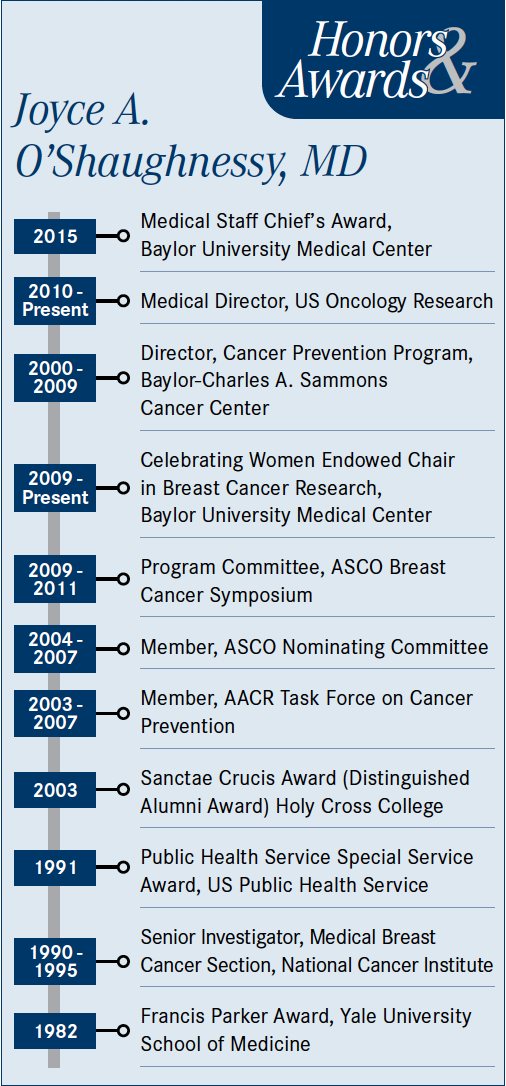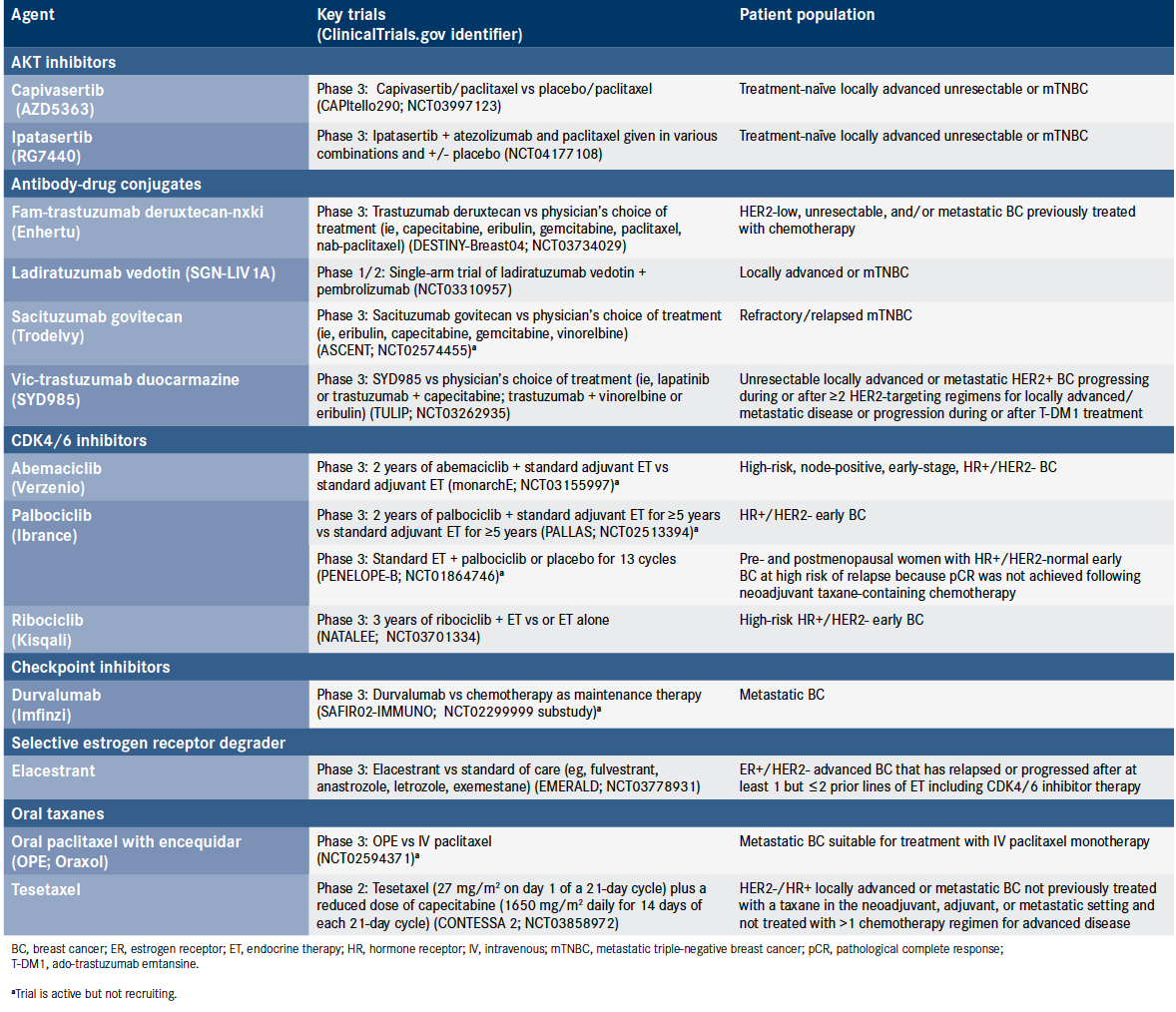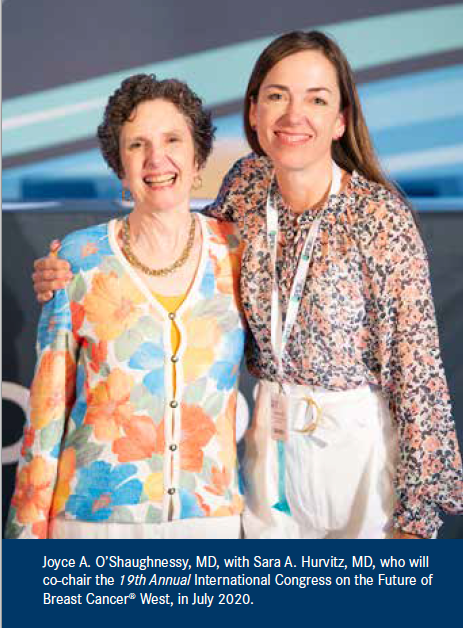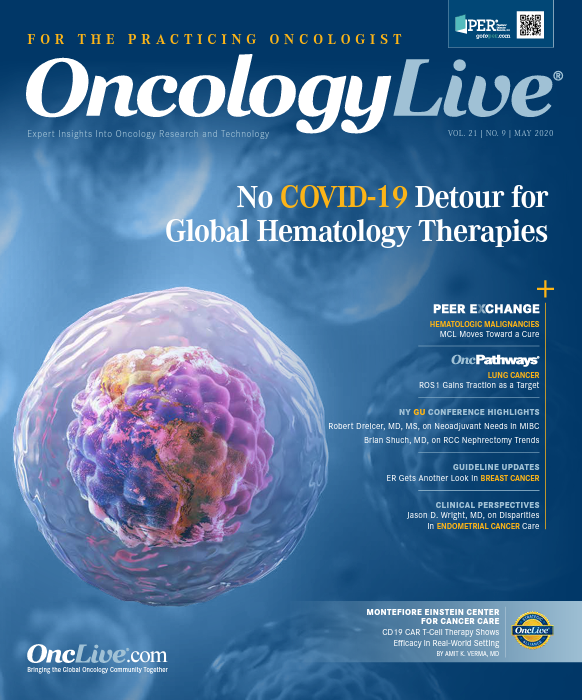Publication
Article
Oncology Live®
Looking Forward to a New Wave of Breast Cancer Therapies
Author(s):
The degree to which nature and nurture affect disease has long been debated in medicine, and it is an issue that esteemed breast cancer researcher and medical oncologist Joyce A. O’Shaughnessy, MD, has been working to unravel for her patients throughout a career that spans more than 30 years.
Joyce A. O’Shaughnessy, MD

The degree to which nature and nurture affect disease has long been debated in medicine, and it is an issue that esteemed breast cancer researcher and medical oncologist Joyce A. O’Shaughnessy, MD, has been working to unravel for her patients throughout a career that spans more than 30 years.
O’Shaughnessy’s care approach strives to consider the whole patient, from determining the importance of germline and somatic mutations and other molecular disease markers, to applying the ever-advancing knowledge at the bedside, to advocating for guidelines and policies that help improve overall quality of life and increase the chances of favorable long-term outcomes for patients and survivors. These efforts include advocating for insurance coverage of nutrition and exercise programs to help overcome treatment-related adverse events and reduce risk of recurrence.
Her endeavors have led to some encouraging outcomes, including for patients with unmet needs who would normally have a poor prognosis. O’Shaughnessy’s practice- changing work in oncology and efforts to educate other clinicians on advances in the field resulted in her becoming a recipient of the 2016 Giants of Cancer Care® award in the community outreach/education category. She is the Celebrating Women Chair in Breast Cancer Research, Baylor University Medical Center, Texas Oncology, and chair, Breast Cancer Program, US Oncology Research.
After a burst of FDA approvals of novel drugs and formulations in less than 18 months, O’Shaughnessy is looking forward to integrating these advancements into clinical practice. Over the next few years, many additional new agents are expected to be approved for breast cancer, and others are likely to receive expanded indications, O’Shaughnessy said in an interview with OncologyLive®.
“It’s truly an exciting and hopeful time in breast cancer because many of the novel agents recently approved and in late-stage development will ultimately improve the long-term outcomes of high-risk early-stage patients, thereby decreasing the global burden of metastatic breast cancer, and there’s no indication that the pace of discovery will slow down any time soon,” she said.
The nature of these emerging therapies and how they fit into the treatment paradigm are among the topics that O’Shaughnessy will tackle this year as she continues her role as a leading breast cancer physician-scientist and educator. She will serve as program chair and co-chair, respectively, for the 19th Annual International Congress on the Future of Breast Cancer® (IBC), which will be held in New York City on July 17 and 18, 2020, (IBC East) and in San Diego, California, on July 31 and August 1, 2020, (IBC West).
The conferences, which are among many medical meetings with which O’Shaughnessy is involved, are hosted by Physicians’ Education Resource®, LLC (PER®). Each meeting features more than 25 sessions that will cover a broad range of novel and practical topics in breast cancer, including new risk-reduction strategies, new algorithms for treating hormone receptor–positive metastatic disease, and the potential emergence of HER2-low breast cancer as a unique subtype. (The meetings currently are scheduled as live events. For updates, visit GoToPER.com).
Additionally, in perhaps her most unusual education project, O’Shaughnessy will chair the 18th Annual School of Breast Oncology®, an intensive 3-day deep dive into the latest data and their clinical implications about breast cancer biology, diagnostics, prevention, and treatment. The program, also hosted by PER®, will take place November 5 through November 7, 2020, in Atlanta, Georgia.
The conference events are indicative of O’Shaughnessy’s standing among her peers. “It is always an absolute pleasure to work with Dr O’Shaughnessy on conferences like the Miami Breast Cancer Conference® and IBC,” said Sara A. Hurvitz, MD, of the Ronald Reagan University of California Los Angeles Medical Center, in Santa Monica, who will co-chair the IBC West Conference. “She is a true leader in the field of breast cancer with a unique grasp on translational approaches that are moving the field forward and an extraordinary ability to clearly convey these results to clinicians and investigators alike.”
The Importance of Learning From Exceptional Responders: A Patient Story
A patient who greatly influenced O’Shaughnessy’s translational and clinical research direction is a woman named Donna, now 68 years old, who was initially diagnosed with triple-negative breast cancer (TNBC) in 2008 at age 56.
As is characteristic of TNBC, Donna experienced multiple recurrences of treatment- refractory disease in her thoracic and supraclavicular lymph nodes. She had undergone several surgical resections and rounds of radiation therapy and had been treated with multiple cytotoxic agents, including taxanes, carboplatin, anthracyclines, alkylators, and antimetabolites. In 2011, she was referred to O’Shaughnessy to be considered for enrollment into a clinical trial. At that time, she had a 3-cm involved left supraclavicular lymph node and no other disease.
“We biopsied the lymph node and performed next-generation sequencing but didn’t find a specific mutation to target therapeutically. Her cancer contained an FOXM1 amplicon and somatic loss-offunction mutation in SMARCA4, which is part of the SWI/SNF family that is involved in double-strand DNA repair, among other things,” O’Shaughnessy said in an interview with OncologyLive®.
Donna was enrolled into a clinical trial assessing dactolisib (BEZ235), an oral agent that inhibits PI3K, mTOR, and the DNA repair protein DNA-PK. “Her cancer responded with a decrease in the size of the left supraclavicular lymph node, but after approximately 6 weeks on therapy, the node began growing very rapidly. This was a definite change in the tempo of her disease, which heretofore had been growing slowly,” O’Shaughnessy said.
The enlarging supraclavicular lymph node was resected, as was a subpectoral lymph node a few months later, which was the patient’s only site of recurrent disease at that time. Shortly after the second resection, however, she developed very rapidly growing internal mammary lymph nodes, some of which were substernal and pushing her sternum out, causing considerable pain. “I treated her with 6 cycles of high-dose nab-paclitaxel [Abraxane] and cisplatin every 3 weeks and obtained a complete response [CR] on CT scan after 2 cycles of therapy. She has been without evidence of disease since 2012,” O’Shaughnessy said.
O’Shaughnessy has analyzed the molecular characteristics of Donna’s serial tumor specimens, including by reverse-phase protein arrays to understand protein pathway activation within her breast cancer. “I think what happened is that the BEZ235 remodeled her cancer by interrupting signaling through the PI3K pathway, inhibited DNA-PK, and shifted signaling in the cancer over to the highly proliferative MAP kinase, MEK/ERK-driven pathway. And BEZ235 increased the degree of homologous recombination deficiency in her breast cancer, which I think was present because of the somatic SMARCA4 loss-of-function mutation seen on next-generation sequencing. These changes likely increased the sensitivity of her cancer to DNA-damaging agents, including cisplatin. So, though Donna had never benefited from chemotherapy before, her remodeled tumor became exquisitely sensitive to cisplatin and nab-paclitaxel following treatment with BEZ235,” O’Shaughnessy explained.
O’Shaughnessy’s experience with Donna, an exceptional responder, shifted the direction of her research toward conducting small, translational pilot trials aimed at increasing BRCAness in metastatic TNBCs, defined as disruptive DNA repair traits that sporadic cancers share with BRCA1/2-mutated tumors.1 The goal of increasing BRCAness is to enhance the effectiveness of DNA-damaging agents and checkpoint inhibitors. She currently has ongoing clinical trials using PI3K/ mTOR inhibitors, a combination of TAK-228 and TAK-117 called PIKTOR (NCT03193853) and LY3023414 (NCT04032080), to evaluate whether these agents can increase homologous recombination deficiency in patients with pretreated metastatic TNBCs.
How It All Started: O'Shaughnessy's Story
O’Shaughnessy has always loved science, but it was a personal experience that set her on the path to medicine. When O’Shaughnessy was in high school, her 5-year-old sister, Teri, developed acute lymphoblastic leukemia, and she watched as her sister was treated on a series of pediatric leukemia clinical trials. Teri succumbed to her disease in 1975, when she was just 10 years old.

At the time, O’Shaughnessy was a student at the College of the Holy Cross in Worcester, Massachusetts, and, after her sister’s death, she decided that cancer research would become her life’s mission. Fortunately, the dean of Holy Cross was very supportive and provided her with funding for her initial study that summer, and she then spent much of her senior year in college studying tumor virology at the Worcester Foundation for Biomedical Research in nearby Shrewsbury, Massachusetts.
After graduating college, O’Shaughnessy went on to pursue her medical degree from Yale University Medical School in New Haven, Connecticut, where she conducted research and wrote her graduation thesis on the biochemical mechanisms of antileukemic agents under the mentorship of 2 very dedicated oncologists, Edwin C. Cadman, MD, and Christopher C. Benz, MD.
Although O’Shaughnessy was initially interested in hematological malignancies because of her sister, a post-fellowship opportunity to transition to the National Cancer Institute’s Clinical Breast Cancer Division to work with her mentor, Kenneth Cowan, MD, PhD, in 1990 cemented her focus on breast cancer. She has since made a considerable impact on the field.
When she first started caring for patients with breast cancer, the treatment landscape was barren, and there had been no improvement in cure rates since the 1930s. Conservative estimates suggest that more than 1 million women died from breast cancer in the United States between 1950 and 1990 alone; a clear trend toward improved survival was not seen until the mid-1990s.2
Table 1. NALA Trial Efficacy Results3

Today, many patients with breast cancer, including those with metastatic disease and the aggressive subtypes, are experiencing improved survival rates due to the rapid pace of discovery, clinical development, and FDA approval of new agents.
O’Shaughnessy’s contributions to the breast cancer armamentarium include key research into the chemotherapeutics gemcitabine, capecitabine, and eribulin mesylate; the CDK4/6 inhibitors abemaciclib (Verzenio) and ribociclib (Kisqali); the immune checkpoint inhibitor pembrolizumab (Keytruda); and numerous targeted therapies including HER2 and PARP inhibitors.
Unlike in the past, when researchers searched for broad-spectrum cancer therapies, today’s treatments are increasingly targeting molecular markers in well-defined breast cancer subtypes. O’Shaughnessy shared her insights on some of the emerging therapies on the horizon that are likely to reshape breast cancer care.
Recent Drug Approvals in Breast Cancer
Neratinib
Neratinib (Nerlynx) is an orally available tyrosine kinase receptor inhibitor of EGFR, HER2, and HER4.3 On February 25, 2020, the drug received FDA approval for a new indication as a combination therapy with capecitabine for adult patients with advanced or metastatic HER2-positive breast cancer who have received 2 or more previous anti-HER2–based regimens in the metastatic setting.4 It was previously approved in 2017 as a single agent for the extended adjuvant treatment of adults with early-stage HER2-positive breast cancer following adjuvant trastuzumab (Herceptin)-based therapy.3
Neratinib’s new indication was approved based on data from the multicenter, openlabel NALA trial (NCT01808573), which randomly assigned patients 1:1 to receive neratinib 240 mg orally once daily on days 1 to 21 with capecitabine 750 mg/m2 given orally twice daily on days 1 to 14 for each 21-day cycle (n = 307) or to lapatinib (Tykerb) 1250 mg orally once daily on days 1 to 21 with capecitabine 1000 mg/m2 given orally twice daily on days 1 to 14 for each 21-day cycle (n = 314).4 The primary end points were progression-free survival (PFS) and overall survival (OS), whereas secondary end points included objective response rate and response duration. Primary and secondary outcome measures were improved with neratinib plus capecitabine versus lapatinib plus capecitabine (Table 13).3,4
“One year of neratinib is a very important therapy for patients with high-risk estrogen receptor–positive breast cancer in the adjuvant setting. I offer it in combination with endocrine therapy following neoadjuvant pertuzumab [Perjeta] and adjuvant T-DM1 [ado-trastuzumab emtansine; Kadcyla], as it substantially reduces the risk of breast cancer recurrence. In my practice, I have seen that neratinib plus capecitabine is an effective combination for patients with HER2-positive brain metastases,” O’Shaughnessy said.
Trastuzumab Deruxtecan
Fam-trastuzumab deruxtecan-nxki (Enhertu) is a HER2-directed antibody and topoisomerase inhibitor conjugate.5 On December 20, 2019, the FDA granted accelerated approval to trastuzumab deruxtecan for patients with unresectable metastatic HER2-positive breast cancer who received 2 or more previous anti-HER2–based regimens in the metastatic setting.6 Approval was based on data from the 2-part, open-label, single-group, multicenter, phase 2 DESTINY-Breast01 (NCT03248492) trial, which included 184 patients who had undergone a median of 6 previous treatments and received the recommended dose of trastuzumab deruxtecan (5.4 mg per/kg of body weight).7
Table 2. Select Trials of Promising Regimens in the Breast Cancer Pipeline

In the intention-to-treat analysis, 112 patients had a response to therapy (60.9%; 95% CI, 53.4-68.0), with a CR rate of 6.0% and a partial response rate of 54.9%. The median duration of response was 14.8 months (95% CI, 13.8-16.9), and the median duration of PFS was 16.4 months (95% CI, 12.7-not reached).7
Several phase 3 trials are ongoing, including DESTINY-Breast02 (NCT03523585), which is evaluating trastuzumab deruxtecan versus the investigator’s choice in patients with HER2-positive, unresectable, or metastatic breast cancer previously treated with standard-of-care HER2 therapies, including T-DM1; DESTINY-Breast03 (NCT03529110), which is comparing trastuzumab deruxtecan versus T-DM1 in patients with HER2-positive, unresectable, or metastatic breast cancer previously treated with trastuzumab and a taxane; and DESTINYBreast04 (NCT03734029), which is assessing trastuzumab deruxtecan versus the investigator’s choice for HER2-low breast cancer that has spread or is unresectable. All 3 trials are currently recruiting patients.
O’Shaughnessy said she is excited about the potential for trastuzumab deruxtecan, which may redefine how women with HER2-low–expressing breast cancers (1+/2+ on immunohistochemistry) are treated if it receives an expanded indication.
“Trastuzumab deruxtecan represents an exciting new strategy because the antibody against HER2, trastuzumab, binds to the breast cancer cells even in the setting of low HER2 expression, enabling the powerful chemotherapy drug, deruxtecan, to be delivered to these and even neighboring HER2-negative cells—the so-called bystander effect,” O’Shaughnessy said. “If the phase 3 DESTINY-Breast04 trial is positive, and the early phase 1/2 data do appear promising, we will have a new subtype of breast cancer, HER2-low, to target with this new agent,” she said.
Approval of trastuzumab deruxtecan in the setting of HER2-low expression would potentially affect a large number of patients, as this group has been estimated to be 2.5 times that of the current HER2- positive population.8
Sacituzumab Govitecan
Sacituzumab govitecan-hziy (Trodelvy) gained an accelerated approval on April 22, 2020, for the treatment of patients with metastatic TNBC who have received 2 or more prior therapies for metastatic disease.9 It is an antibody-drug conjugate that combines a humanized monoclonal antibody with SN-38 in a way that enables high concentrations of SN-38 to be delivered to tumors.10
In a phase 1/2 multicenter trial (NCT01631552) that included 108 patients, investigator assessment showed an objective response rate of 33.3%, with 3 CRs and 33 partial responses. The median duration of response was 7.7 months. Post hoc assessment by independent central review showed a response rate of 34.3% and median duration of response of 9.1 months. The clinical benefit rate was 45.4%, the median PFS was 5.5 months (95% CI, 4.1-6.3), and the median OS was 13.0 months (95% CI, 11.2-13.7).10
Sacituzumab govitecan is being assessed in the phase 3 ASCENT study (NCT02574455) in patients with relapsed or refractory metastatic TNBC who have been treated with 2 or more anticancer agents. The study, which has an estimated enrollment of 529 patients, is randomizing participants 1:1 to receive either sacituzumab govitecan (10 mg/kg on days 1 and 8 of a 21-day cycle) or physician’s choice of chemotherapy (eribulin, capecitabine, gemcitabine, or vinorelbine).
Tucatinib
On April 17, 2020, the FDA approved tucatinib (Tukysa) in combination with trastuzumab and capecitabine for patients with locally advanced or unresectable metastatic HER2-positive breast cancer, including patients with brain metastases previously treated with HER2-targeting therapies.11 It is an oral, small-molecule tyrosine kinase receptor inhibitor that is highly selective for HER2.

In the phase 2 HER2CLIMB trial (NCT02614794), the PFS rate at 1 year was 33.1% among those who received the tucatinib-containing regimen versus 12.3% for participants who took placebo, trastuzumab, and capecitabine; the median PFS was 7.8 months (95% CI, 7.5-9.6) and 5.6 months (95% CI, 4.2-7.1), respectively, (HR, 0.54; 95% CI, 0.42- 0.71; P <.001).12
At 2 years, the OS rate was 44.9% in the tucatinib group and 26.6% in the comparator arm; the median OS was 21.9 months (95% CI, 18.3-31.0) and 17.4 months (95% CI, 13.6-19.9), respectively, (HR, 0.66; 95% CI, 0.50-0.88; P = .005). Among the patients with brain metastases, PFS at 1 year was 24.9% in the tucatinib-combination group and 0% in the placebo-combination group, and the median PFS was 7.6 months (95% CI, 6.2-9.5) and 5.4 months (95% CI, 4.1-5.7), respectively.12
HER2CLIMB is the first completed randomized trial to include and show benefit in patients with HER2-positive breast cancer and brain metastases.13
Novel Therapies in Late-Stage Development
Margetuximab
Margetuximab is being assessed in the phase 3 SOPHIA trial (NCT02492711), which is comparing this agent in combination with chemotherapy versus trastuzumab plus chemotherapy in patients with HER2-positive metastatic breast cancer previously treated with anti–HER2–targeted therapies. Margetuximab is a crystallizable fragment-engineered anti-HER2 monoclonal antibody that is similar to trastuzumab, targeting the same epitope and exerting similar antiproliferative effects but with enhanced immune activity against HER2-expressing tumor cells.14
The second interim OS analysis, which was planned after 270 deaths (cutoff September 2019), showed a median OS of 21.6 months (95% CI, 18.86-24.05) for the margetuximab-containing regimen versus 19.8 months (95% CI, 17.54-22.28) for trastuzumab-based therapy plus chemotherapy, a finding that did not reach statistical significance (stratified log-rank P = .326).15 The final prespecified OS analysis is planned after 385 deaths and projected to occur in the second half of 2020.
However, exploratory analysis of patients carrying a specific genotype of CD16A, the CD16A 158F allele, had a larger OS benefit with margetuximab. In the second interim analysis, their median OS was prolonged by 4.3 months versus trastuzumab (23.7 vs 19.4 months, respectively; HR, 0.79; 95% CI, 0.61-1.04; nominal P = .087). Approximately 85% of participants in the SOPHIA trial had the CD16A 158F allele, which represents its prevalence in the general human population.15 In contrast, the patients who did not have the CD16A 158F allele (15%) had a better survival outcome with the trastuzumab combination.
On December 19, 2019, based on the SOPHIA data, margetuximab’s manufacturer, MacroGenics, announced it had submitted a biologics license application to the FDA.16 It previously received fast-track designation for margetuximab on January 23, 2018.17
Pembrolizumab:
Neoadjuvant and First-Line Metastatic Settings
Pembrolizumab, a humanized, anti–PD-1 monoclonal antibody, is showing promise when added to chemotherapy in the neoadjuvant and first-line metastatic settings for women with TNBC or hormone receptor–positive/HER2-negative disease.
In February 2020, both the phase 2 adaptively randomized I-SPY2 trial (NCT01042379) and the phase 3 randomized KEYNOTE-522 trial (NCT03036488) reported positive results in the neoadjuvant setting,18,19 and the KEYNOTE-355 (NCT02819518) trial investigators announced that pembrolizumab in combination with chemotherapy had met the study’s primary end point of PFS in the first-line setting in patients with metastatic TNBC whose tumors had PD-L1 combined positive scores of 10% or greater.20
The I-SPY2 trial assessed pembrolizumab in combination with taxane- and anthracycline- based neoadjuvant chemotherapy in 250 women with early-stage breast cancer.18 The addition of pembrolizumab to standard neoadjuvant chemotherapy more than doubled pathological CR (pCR) rates compared with chemotherapy alone for both hormone receptor–positive/HER2-negative disease and TNBC. Final estimated pCR rates, evaluated in March 2017, were 44% versus 17%, 30% versus 13%, and 60% versus 22% for pembrolizumab plus neoadjuvant chemotherapy versus standard neoadjuvant chemotherapy in the HER2-negative, hormone receptor–positive /HER2-negative, and TNBC cohorts, respectively.18
The KEYNOTE-522 trial randomly assigned patients who were treatment naïve and had stage II or stage III TNBC in a 2:1 ratio to receive neoadjuvant therapy with pembrolizumab plus paclitaxel and carboplatin (n = 784) or placebo plus paclitaxel and carboplatin (n = 390).19 Both groups then received an additional 4 cycles of pembrolizumab or placebo, as well as doxorubicin-cyclophosphamide or epirubicin-cyclophosphamide.
After definitive surgery, patients received adjuvant pembrolizumab or placebo every 3 weeks for up to 9 cycles. The first interim analysis, which included the first 602 patients who underwent randomization, showed a pCR of 64.8% (95% CI, 59.9-69.5) in the pembrolizumab-chemotherapy group and 51.2% (95% CI, 44.1-58.3) in the placebo-chemotherapy group (P <.001). After a median follow-up of 15.5 months, 58 patients (7.4%) in the pembrolizumab-chemotherapy group and 46 patients (11.8%) in the placebo-chemotherapy group had disease progression that precluded definitive surgery, had local or distant recurrence or a second primary tumor, or died from any cause.19
Emerging Treatment Strategies: 2021 and Beyond
O’Shaughnessy said that many other agents in earlier phases of clinical development across the breast cancer spectrum are also showing considerable promise, with FDA approvals anticipated over the next few years. Some of the agents she mentioned are outlined in Table 2.
“In 2021, I hope we have clinical availability of an antibody-drug conjugate called SYD985 [vic-trastuzumab duocarmazine], which is another promising anti-HER2– based therapy currently being evaluated in the phase 3 TULIP trial [NCT03262935]. And, importantly, I’m hoping the ongoing phase 3 adjuvant trials of palbociclib [Ibrance], abemaciclib, and ribociclib are also positive and become standards of care for patients with high-risk estrogen receptor-positive breast cancer,” she said.
Other agents that O’Shaughnessy believes are likely to influence the standard management of patients with breast cancer in the future include the ATK inhibitors capivasertib and ipatasertib; the checkpoint inhibitors atezolizumab (Tecentriq), nivolumab (Opdivo), and durvalumab (Imfinzi) in the neoadjuvant and adjuvant settings; the selective estrogen receptor degrader elacestrant; the novel antibody- drug conjugate ladiratuzumab vedotin (SGN-LIV1A); and the oral taxanes OPE (oral paclitaxel with encequidar) and tesetaxel.
The door was opened for checkpoint inhibitor therapy in breast cancer on March 8, 2019, when the FDA approved atezolizumab, a PD-L1 inhibitor, in combination with nab-paclitaxel for patients with unresectable locally advanced or metastatic TNBC whose tumors exhibit PD-L1 expression of 1% or more on tumor-infiltrating immune cells.21
Keeping Up With the Everchanging Treatment Landscape
The many treatments O’Shaughnessy discussed are only a sampling of what is yet to come, as breast cancer continues to receive a tremendous amount of investment. A 2019 report in the Journal of the National Comprehensive Cancer Network that examined cancer funding by nonprofit organizations found that, in 2015, breast cancer initiatives received $460 million of the $6 billion generated by the 119 cancerrelated nonprofits included in the study.22
This funding has enabled the development of significant therapeutic advances for patients with breast cancer but has created a challenge for oncologists in learning about and applying ever-evolving new information in their practices. Attending meetings such as the Miami Breast Cancer Conference®, IBC East, IBC West, and the School of Breast Oncology® is a way oncologists and other practitioners can make sure they are up to date on all the key advances that will help their patients, O’Shaughnessy explained.
“There are many new data oncologists can apply tomorrow in their practices, but they have to know which patients and when they may benefit from new therapies, and what the risks are,” she said.
For example, tucatinib became available for patients through an expanded-access program before the FDA approved it. “These are the types of topics we cover in depth at the IBC East and West meetings and School of Breast Oncology®,” O’Shaughnessy said.
References
- Turner N, Tutt A, Ashworth A. Hallmarks of 'BRCAness' in sporadic cancers. Nat Rev Cancer. 2004;4(10):814-819. doi:10.1038/nrc1457
- Borgen P. Breast cancer in the 20th century: quest for the ideal therapy. Ochsner J. 2000;2(1):5-9.
- Nerlynx. Prescribing information. Puma Biotechnology, Inc; 2020. Accessed April 28, 2020. https://www.accessdata.fda.gov/drugsatfda_docs/label/2020/208051s005s006lbl.pdf
- FDA approves neratinib for metastatic HER2-positive breast cancer. FDA. Published February 25, 2020. Accessed March 8, 2020. https://www.fda.gov/drugs/resources-information-approved-drugs/fda-approves-neratinib-metastatic-her2-positive-breast-cancer
- Enhertu. Prescribing information. Daiichi Sankyo, Inc; 2019. Accessed April 28, 2020. https://www.accessdata.fda.gov/drugsatfda_docs/label/2019/761139s000lbl.pdf
- FDA approves fam-trastuzumab deruxtecan-nxki for unresectable or metastatic HER2-positive breast cancer. FDA. Published December 20, 2019. Accessed March 25, 2020. https://www.fda.gov/drugs/resources-information-approved-drugs/fda-approves-fam-trastuzumab-deruxtecan-nxki-unresectable-or-metastatic-her2-positive-breast-cancer
- Modi S, Saura C, Yamashita T, et al; DESTINY-Breast01 Investigators. Trastuzumab deruxtecan in previously treated HER2-positive breast cancer. N Engl J Med. 2020;382(7):610-621. doi:10.1056/NEJMoa1914510
- Liu A. AZ, Daiichi's new cancer drug Enhertu gets off to the races with quick U.S. launch. FiercePharma. Published February 10, 2020. Accessed March 8, 2020. https://www.fiercepharma.com/marketing/az-daiichi-s-new-cancer-drug-enhertu-gets-off-to-races-quick-u-s-launch
- FDA grants accelerated approval to sacituzumab govitecan-hziy for metastatic triple negative breast cancer. FDA. Published April 22, 2020. Accessed April 28, 2020. https://www.fda.gov/drugs/drug-approvals-and-databases/fda-grants-accelerated-approval-sacituzumab-govitecan-hziy-metastatic-triple-negative-breast-cancer
- Bardia A, Mayer IA, Vahdat LT, et al. Sacituzumab govitecan-hziy in refractory metastatic triple-negative breast cancer. N Engl J Med. 2019;380(8):741-751. doi:10.1056/NEJMoa1814213
- FDA approves tucatinib for patients with HER2-positive metastatic breast cancer. FDA. Published April 20, 2020. Accessed April 28, 2020. https://www.fda.gov/drugs/resources-information-approved-drugs/fda-approves-tucatinib-patients-her2-positive-metastatic-breast-cancer
- Murthy RK, Loi S, Okines A, et al. Tucatinib, trastuzumab, and capecitabine for HER2-positive metastatic breast cancer. N Engl J Med. 2020;382(7):597-609. doi:10.1056/NEJMoa1914609
- Goodman A. Tucatinib combination extends survival in her2-positive metastatic breast cancer, including patients with brain metastases. The ASCO Post. Published January 25, 2020. Accessed March 8, 2020. bit.ly/3cWI97Y
- Rugo HS, Im SA, Cardoso F, et al; SOPHIA Study Group. Phase 3 SOPHIA study of margetuximab + chemotherapy vs trastuzumab + chemotherapy in patients with HER2+ metastatic breast cancer after prior anti-HER2 therapies: second interim overall survival analysis. Cancer Res. 2020;80(suppl 4; abstr GS1-02). doi:10.1158/1538-7445.SABCS19-GS1-02
- Rugo HS, IM SA, Cardoso F, et al; SOPHIA Study Group. Phase 3 SOPHIA study of margetuximab + chemotherapy vs trastuzumab + chemotherapy in patients with HER2+ metastatic breast cancer after prior anti-HER2 therapies: second interim overall survival analysis. Presented at: San Antonio Breast Cancer Symposium; December 10-14, 2019; San Antonio, TX. Abstract 752. http://ir.macrogenics.com/static-files/fbaf7453-40cf-4d0b-b7c8-1adadc4ea7b3
- MacroGenics announces submission of margetuximab biologics license application to U.S. FDA. News release. Rockville, MD; MacroGenics, Inc; December 19, 2019. Accessed March 8, 2020. https://bit.ly/2xs9QFm
- MacroGenics announces continuation of SOPHIA study of margetuximab based on completion of interim futility analysis. News release. Rockville, MD; MacroGenics, Inc; January 23, 2018. Accessed March 8, 2020. https://bit.ly/2vTygac
- Nanda R, Liu MC, Yau C. Effect of Pembrolizumab plus neoadjuvant chemotherapy on pathologic complete response in women with early-stage breast cancer an analysis of the ongoing phase 2 adaptively randomized I-SPY2 trial. Published online February 13, 2020. JAMA Oncol. doi:10.1001/jamaoncol.2019.6650
- Schmid P, Cortes J, Pusztai L, et al; KEYNOTE-522 Investigators. Pembrolizumab for early triple-negative breast cancer. N Engl J Med. 2020;382(9):810-821. doi:10.1056/NEJMoa1910549
- Merck’s Keytruda (pembrolizumab) in combination with chemotherapy met primary endpoint of progression-free survival (PFS) as first-line treatment for metastatic triple-negative breast cancer (mTNBC). News Release. Kenilworth, NJ: Merck; February 12, 2020. Accessed April 29, 2020. https://bit.ly/3aPZJbe
- FDA approves atezolizumab for PD-L1 positive unresectable locally advanced or metastatic triple-negative breast cancer. FDA. Published March 18, 2019. Accessed May 28, 2020. https://www.fda.gov/drugs/drug-approvals-and-databases/fda-approves-atezolizumab-pd-l1-positive-unresectable-locally-advanced-or-metastatic-triple-negative
- Kamath SD, Kircher SM, Benson AB. Comparison of cancer burden and nonprofit organization funding reveals disparities in funding across cancer types. J Natl Compr Canc Netw. 2019;17(7):849-854. doi: 10.6004/jnccn.2018.7280






























%20(2)%201-Recovered-Recovered-Recovered-Recovered-Recovered-Recovered-Recovered-Recovered-Recovered-Recovered-Recovered-Recovered-Recovered-Recovered-Recovered-Recovered-Recovered.jpg?fit=crop&auto=format)
%20(2)%201-Recovered-Recovered-Recovered-Recovered-Recovered-Recovered-Recovered-Recovered-Recovered-Recovered-Recovered-Recovered-Recovered-Recovered-Recovered-Recovered-Recovered.jpg?fit=crop&auto=format)
